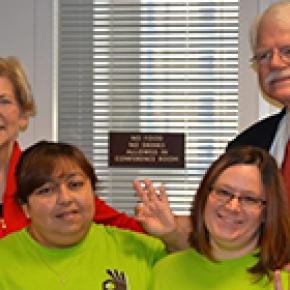After A Wave Of Bad Press, This Controversial Software Company Is Making Changes
In April, the New York attorney general’s office launched an ...
In April, the New York attorney general’s office launched an investigation into the scheduling practices of 13 national retail chains, distributing a letter to the Gap, Target, J.C. Penney, and 10 other companies. The letter asked, among other things, whether these companies’ store managers use software manufactured by a company called Kronos to algorithmically generate schedules.
A few months later, Kronos was also featured prominently in an article published by the New York Times about the ill effects of erratic scheduling on Starbucks employees, especially one particular family. In a follow-up piece, the author, Jodi Kantor, points directly to Kronos’ scheduling software as the root of the problem. “I saw that her life was coming apart and that the Starbucks software had contributed to the crisis,” Kantor wrote of one of the story’s subjects.
The piece’s argument centered around the financial and scheduling unpredictability engendered by platforms like Kronos. When you don’t know if your shift might be canceled, if or when you’ll be called in, or what your hours will look like next week or the week after, it becomes very difficult to make even the most basic plans for your future. This can have devastating long-term financial and emotional impacts on workers. According to a recent study by the Economic Policy Institute, a left-leaning think tank in Washington, D.C., 17 percent of the American workforce is negatively affected by unstable schedules.
For their part, Kronos representatives argue that the algorithm is far from the root of the problem. “The populist view is that scheduling is evil, in that it’s causing erratic schedules for employees, and so forth,” Charlie DeWitt, vice president of business development for Kronos, told BuzzFeed News. “The fact of the matter is it’s an algorithm. It does whatever you want it to do.”
And you don’t necessarily need to work for Kronos to believe that in a competitive retail climate, the problem is more complicated than technology alone. Lonnie Golden, a Penn State economist who has extensively studied the impact of erratic scheduling, acknowledges that Kronos’ product itself is less to blame than the managers who make staffing decisions based on the data it provides. “It’s not necessarily the technology that’s responsible for minimum to no advance notice,” he said. “It’s the way in which it’s applied.”
But, he added, “where there’s a technology problem, there’s usually a technology solution.” And while Kronos maintains that managers, and not the software, are responsible for early dismissals and last-minute shift cancellations, the company is nonetheless pursuing some technological solutions.
Kronos wants to help managers better understand how scheduling adjustments affect workers and, ultimately, the bottom line. Though the company maintains that its software doesn’t produce the kind of erratic schedules that hurt wage workers, DeWitt said there was nonetheless an interest in figuring out why that perception existed — and, if possible, fixing it.
To that end, earlier this month at a retail conference in Philadelphia, the company announced that it’s working on a new plug-in that will give managers better insight into workers’ schedule stability, equity of hours worked among employees, and the consistency of schedules from week to week. In addition, Kronos is improving a feature meant to help give employees more control over their schedules: Though the software already incorporates employee availability and preferences into its scheduling calculations, improvements to a shift-swapping feature on its employee-facing web and mobile apps will theoretically allow employees to work around conflicts among themselves.
Golden said increased employee input and control would be a good thing. But some retailers, DeWitt pointed out, are uncomfortable making workers use an app outside of work hours; indeed, the practice could be seen as a shift of management responsibilities onto lower-paid individuals.
Part of the idea behind the new Kronos plug-in is to help companies tie fairer scheduling practices to reduction in absenteeism and turnover, which can be enormously costly. In other words, if Kronos can help executives see the connection between treating workers fairly and a store’s ability to increase revenue, DeWitt said, managers will have an impetus to create more predictable, stable schedules.
And just because companies are looking at this kind of data doesn’t mean they have to use it. “Companies like Kronos and Workplace Systems are starting to integrate some of these principles into their software,” said Carrie Gleason, director of the Fair Workweek Initiative at the Center for Popular Democracy, “but it’s all optional, so companies can decide not to do it.” While 12 states are currently considering legislation that would create new labor standards around the workweek, Gleason said the technology alone lacks a mechanism for enforcement.
Given market pressures and standard management practices, it’s unlikely that any change to Kronos’ technology would give workers more power — especially because, given the competitive retail climate at the moment, the bottom line tends to be the priority. “It’s not just bad managers. They have extreme pressure to increase productivity on an ever-shrinking labor budget,” Gleason said.
With these changes, Kronos has taken logical steps toward both repairing its reputation and making sure its software creates sustainable work environments. But while the company cannot control exactly how the algorithm that forecasts schedules and optimizes workforces is deployed inside different workplaces, the Kronos engineers who designed the product are nonetheless the partial architects of work environments that have been proven to be untenable for low-wage workers. The Kronos scheduling algorithm isn’t designed to serve those people; it’s designed to be sold to their bosses, and as such, will ultimately be shaped to serve the needs of management — until regulations exist that compel them to change how it’s used.
Source: Buzzfeed
Nationwide #DisneyLetHimGo Protests Call on Disney CEO to Leave Trump Council
NATIONWIDE - Today the Center for Popular Democracy and its affiliates including Organize Florida and ACCE, together...
NATIONWIDE - Today the Center for Popular Democracy and its affiliates including Organize Florida and ACCE, together with national allies Color of Change, CREDO, Free Press, MoveOn.org, People’s Action, SumOfUs.org and Working Families Party protested Disney locations around the country. Following the lead of Orlando Disney workers and Orlando community groups, the social justice groups called on Walt Disney Company CEO Bob Iger to step down from his role as a member of Trump’s Business Advisory Council. The coalition collected over 390,000 petitions to Disney on behalf of people from across the country who demand Iger leave the council.
“Disney has the power to take a stand against Trump and support a happy ending for all families. They must follow in Uber’s footsteps and quit the economic advisory council instead of collaborating with Trump and his authoritarian, hateful, anti-immigrant regime,” said Jennifer Epps-Addison, Network President and Co-Executive Director for the Center for Popular Democracy.
Racial and social justice activists say this is only the first step in what will be a continuous fight to protect the health and well-being of all people — including immigrants, people of color, minimum wage workers, and the LGBT community during the Trump administration. Disney is one of more than a dozen other corporations still on Trump’s economic advisory council. CPD aims to hold each and every one of them accountable.
“Donald Trump has built his brand and presidency by disparaging Latino, Muslim, and Black communities as well as women and people with disabilities. As a corporation that has touted itself as valuing diversity, inclusion and family I would think that CEO Bob Iger would seek to distance himself, not embrace or enable Trump and Steve Bannon’s bigoted agenda. But instead, Iger and other CEOs continue to place access to power over people’s lives under the false pretense of influencing positive change. To be clear- any CEO who thinks they can disrupt Trump and Bannon’s agenda is either disingenuous or fooling themselves” said Rashad Robinson, Executive Director of Color Of Change.
"By standing with Trump, Iger has mistaken his role as the CEO of the Walt Disney Company. He cannot just represent the business concerns of the company for trade and tax regulations, but must also represent the ethics and values that the Disney brand sells to families around the world. It’s time that our corporations put immigrants, workers and refugees first" said Yulissa Arce, Central Florida Director, Organize Florida.
"It is appalling that any leader would be willing to advance company interests on the backs of the people most threatened by Trump’s hate,” said Heidi Hess, Senior Campaign Manager at CREDO. "CEOs like Disney’s Bob Iger who serve on Trump’s advisory councils have to make a choice: Stand up for morality and human dignity or side with Trump’s racist, misogynistic and xenophobic hate."
The announcement comes after successful protests around the country led to the resignation of Uber CEO Travis Kalanick from the Trump business council. Last week, drivers and other community organizations organized #UberRidesWithHate protests at Uber offices in New York City, San Francisco, and New Orleans, among other nationwide locations, demanding that the ride-sharing company stop collaborating with the Trump administration.
"Disney is known for it's fun-loving family movies. But there's nothing fun about what the Trump Administration is doing to immigrant families. Disney can sing 'It's a Small World' all they want, but until Bob Iger steps down from Trump's economic advisory council, they'll be singing out of tune, “ said Liz Ryan Murray, Policy Director at People's Action.
"Disney CEO Bob Iger is validating Trump’s violent agenda by serving on his advisory council.” explained Nicole Carty, Campaign Manager for SumOfUs.org. “We know Iger supports immigration, and has employees that will be impacted by the ban. By remaining on Trump’s advisory board Iger is signaling his own interests and profits are more important than the basic human rights of his employees, customers and vulnerable refugees. There is no neutral,” added Carty. “Either Iger steps off the advisory committee, or he is complicit in the violence and chaos that Trump’s administration is creating.”
###
www.populardemocracy.org
Center for Popular Democracy promotes equity, opportunity, and a dynamic democracy in partnership with innovative base-building organizations, organizing networks and alliances, and progressive unions across the country. CPD builds the strength and capacity of democratic organizations to envision and advance a pro-worker, pro-immigrant, racial justice agenda
Report: Black Minnesotans Missing Out On Economic Recovery
CBS Minnesota - March 5, 2015 - African Americans are not experiencing the same economic recovery compared to others in...
CBS Minnesota - March 5, 2015 - African Americans are not experiencing the same economic recovery compared to others in the country, according to a new report from the Economic Policy Institute and the Center for Popular Democracy.
Some organizations say Minnesota is experiencing a crisis level of inequality with wages and jobs.
Black unemployment is four times higher than whites in the state.
“It’s a report that shows, I think, what we already knew,” Neighborhoods Organizing for Change’s Anthony Newby said.
He says he did not need a report to know the challenges faced by many in his community.
“If you look right outside the door here on Broadway Avenue, you’ll see a total lack of industry. We’ve got low-wage jobs, low-wage opportunities,” Newby said. “We’re a mile and a half or so from downtown Minneapolis, which is considered one of the economic hubs, certainly of the Midwest.”
The report spells out how the economy is bouncing back, but not for African Americans — especially those who live in Minnesota.
Since 2000, wages have decreased by 44 cents an hour for African Americans. This statistic does not ring true for whites or Latinos.
“We’re told that Minnesota is one of the best places in the country to live if you want a job, and that’s true if you’re a white person. Unemployment is 2.8 percent. If you’re black, its 10.9 percent,” Newby said.
Kentha Parker says she is more than a statistic.
“I’ve been looking for work since 2011, since the tornado,” Parker said.
She’s a mother who is struggling to find work to take care of her family. She says she’s tired of hearing these words: “We’re not hiring at this time, we’ll keep your application on file."
“The Federal Reserve, which has a branch right here in Minneapolis, could do a lot to actually influence the general economy,” Newby said.
He believes the Federal Reserve has the power to keep interest rates low, which in turn could boost wages and help reduce income inequality.
Newby says Neighborhoods Organizing for Change will push to be a part of the conversation.
He wants to see people of color at the table when the Federal Reserve produces its policies.
Source
GOP pours nearly $1M into Arizona special election
Activist Ady Barkan and New York Times columnist Michelle Goldberg discuss what’s been happening on the ground in...
Activist Ady Barkan and New York Times columnist Michelle Goldberg discuss what’s been happening on the ground in Arizona, where the outcome of the special election in the 8th district is perhaps less important than the margin.
Watch the video here.
Ahead of Black Friday, Walmart Workers Brief Capitol Hill Lawmakers
People's World - November 19, 2014 - Sen. Elizabeth Warren, D, Mass., Rep. George Miller, D,Calif., and legislative...
People's World - November 19, 2014 - Sen. Elizabeth Warren, D, Mass., Rep. George Miller, D,Calif., and legislative experts held a committee briefing today, titled Walmart and the Economic Insecurity of American Families. Only a week before Black Friday job actions that are expected at more than 1,000 Walmart stores nationwide the lawmakers heard from members of OUR Walmart on how the country's largest employer is creating an economic crisis for working families in America.
"I was glad to join Walmart employees today to support efforts to push back against practices by Walmart and other big corporations that make it hard for working families to make ends meet," said Warren. "Hardworking men and women across the country want a fighting chance to build a future for themselves and their families. We need to give workers this chance by raising the minimum wage, providing some basic fairness in scheduling, and fighting for equal pay for equal work."
"Walmart's shoddy business model is singlehandedly wreaking havoc on American families across the country and making it impossible for hundreds of thousands of workers to have a shot at the American Dream," said Miller, senior Democrat on the House Committee on Education and the Workforce. "America's workers and their families deserve better than they're getting from Walmart today-they deserve higher wages, less erratic schedules, and equal pay regardless of their gender. The courage of Walmart workers who are engaged in sit-down strikes to protest the company's illegal silencing of workers who have called for better jobs and full-time work is essential to creating real change."
At the Senate Health, Education, Labor and Pensions Committee briefing, Walmart workers discussed how Walmart's low pay, manipulation of scheduling and illegal threats to workers have created a new norm across industries that makes it nearly impossible for workers to hold down second jobs, arrange child care, go to school or manage health conditions.
"With Walmart's low-wages and hectic schedules, too many Walmart workers are left on the edge of poverty. But all too often when we stand up, Walmart tries to silence us. Just days before I planned to participate in our first sit-down strike in LA, Walmart fired me for speaking up for better wages and hours, but I'm still fighting today because my former colleagues like Fatmata Jabbie and Cantare Davunt deserve better," said Evelin Cruz, former Walmart employee and OUR Walmart member.
The briefing highlighted the Schedules That Work Act, Fair Minimum Wage Act and Paycheck Fairness Act-legislation that would force the company to improve its pay and hours for hundreds of thousands of American workers. Legislative experts including Carol Joyner of the Labor Project for Working Families, Amy Traub of Demos and Carrie Gleason of the Center for Popular Democracy joined the elected officials and Walmart associates on the panel to discuss the need for legislative action to set a new standard at the country's largest employer.
The action from elected officials comes as an increasing number of Americans and Walmart workers point to OUR Walmart as making significant changes at the country's largest retailer. Most recently, after public calls from OUR Walmart, the company committed to raise wages for its lowest paid workers and rolled out a new scheduling system that allows workers to sign up for open shifts. To date, workers at more than 2,100 Walmart stores nationwide have signed a petition calling on Walmart and the Waltons to publicly commit to paying $15 an hour and providing consistent, full-time hours.
"In three short years, OUR Walmart has grown to a powerful, national network that is making big changes at the country's largest employer," said Cantare Davunt, a Walmart customer service manager and OUR Walmart member during the briefing today."But more needs to be done. Legislative action would have a huge impact, but Walmart can lead the way now by adopting policies that give us the schedules and pay we need."
The briefing comes before next week's Black Friday nationwide strikes. Tens of thousands of workers, teachers, voters, clergy, environmentalists, and civil rights leaders will join workers at more than 1,600 protests, speaking out against retaliation and calling on Walmart and the Walton family to publicly commit to $15 an hour and provide full-time work.
Source
'Secure scheduling' rallies focus on giving hourly workers more stability

'Secure scheduling' rallies focus on giving hourly workers more stability
Dive Brief: New York City Mayor DeBlasio and several advocate groups gathered recently to show support for the...
Dive Brief:
New York City Mayor DeBlasio and several advocate groups gathered recently to show support for the introduction of “Fair Workweek” legislation, designed to ensure that 65,000 hourly employees in the fast food industry receive fair notification on work hours.
Currently, employers nationwide aren’t required to provide their hourly employees with advance notice of upcoming shifts. As a result, too many families can't budget in advance, plan for education or family care, or secure a necessary second job, according to advocates.
The New York City event echoes the demands of coalition of New York-based advocates who launched a national campaign on Sept. 6. The groups — the Center for Popular Democracy, the Rockefeller Foundation and the online organization Purpose — are asking for scheduling at least two weeks in advance, eliminating on-call assignments that leave employees "scrambling for child care and unable to hold second jobs with uncertain paychecks."
Dive Insight:
Employers do realize that predictability and fairness are reasonable demands, but more often than not, labor cost (and in some cases, labor shortage) creates problems when trying to create better schedules. Frontline managers are expected to create the schedules while also trying to keep costs down, and balancing the two expectations isn't always successful.
What it will take is better workforce planning, with some technology solutions already available to help make that happen, say experts. Also, there are potential negative legal and compliance outcomes for employers who don't follow state and local laws that already require "reporting pay" time be allowed.
By Tom Starner
Source
The Fed’s about to try something that almost always has ended in recession

The Fed’s about to try something that almost always has ended in recession
The Federal Reserve‘s looming attempt to shrink its mammoth portfolio of bonds comes with an ugly track record:...
The Federal Reserve‘s looming attempt to shrink its mammoth portfolio of bonds comes with an ugly track record: Virtually every time the central bank has tried it in the past, recessions have followed.
Over the past several months, the Fed has prepared markets for the upcoming effort to reduce the $4.5 trillion it currently holds of mostly Treasurys and mortgage-backed securities. The balance sheet ballooned as the Fed sought to stimulate the economy out of its financial crisis morass.
Read the full article here.
Maria Gallagher, Ana Maria Archila and the amazing power of everyday people raising their voice

Maria Gallagher, Ana Maria Archila and the amazing power of everyday people raising their voice
Maria Gallagher, a 23-year-old woman from New York, had never told anyone about the time she was sexually assaulted...
Maria Gallagher, a 23-year-old woman from New York, had never told anyone about the time she was sexually assaulted before she blurted it out to a United States senator, Republican Jeff Flake of Arizona, with millions watching on live national television.
Read the full article here.
So-Called 'Common Sense' Immigration Plan Denounced as 'Mass Deportation Bill'

So-Called 'Common Sense' Immigration Plan Denounced as 'Mass Deportation Bill'
Following news on Wednesday that a bipartisan group of senators known as the "Common Sense Caucus" reached a deal on an...
Following news on Wednesday that a bipartisan group of senators known as the "Common Sense Caucus" reached a deal on an immigration measure that would grant President Donald Trump's demands for border wall funding and cuts to family reunification programs, immigrant rights groups denounced the proposed plan as a "mass deportation bill" and implored Democrats to vote against it.
Read the full article here.
MSNBC - The ED Show - Boehner pushes exclusionary school legislation
MSNBC The ED Show - May 9, 2014 - John Boehner pushed the charter school agenda one step further by supporting...
MSNBC The ED Show - May 9, 2014 - John Boehner pushed the charter school agenda one step further by supporting legislation to pour even more funding into the program. Ed Schultz, Ruth Conniff, and St. Rep. Dwight Bullard discuss.
.











2 months ago
2 months ago